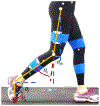Analysis of Continuously Varying Kinematics for Prosthetic Leg Control Applications
- PMID: 33320814
- PMCID: PMC7920935
- DOI: 10.1109/TNSRE.2020.3045003
Analysis of Continuously Varying Kinematics for Prosthetic Leg Control Applications
Abstract
Powered prosthetic legs can improve the quality of life for people with transfemoral amputations by providing net positive work at the knee and ankle, reducing the effort required from the wearer, and making more tasks possible. However, the controllers for these devices use finite state machines that limit their use to a small set of pre-defined tasks that require many hours of tuning for each user. In previous work, we demonstrated that a continuous parameterization of joint kinematics over walking speeds and inclines provides more accurate predictions of reference kinematics for control than a finite state machine. However, our previous work did not account for measurement errors in gait phase, walking speed, and ground incline, nor subject-specific differences in reference kinematics, which occur in practice. In this work, we conduct a pilot experiment to characterize the accuracy of speed and incline measurements using sensors onboard our prototype prosthetic leg and simulate phase measurements on ten able-bodied subjects using archived motion capture data. Our analysis shows that given demonstrated accuracy for speed, incline, and phase estimation, a continuous parameterization provides statistically significantly better predictions of knee and ankle kinematics than a comparable finite state machine, but both methods' primary source of predictive error is subject deviation from average kinematics.
Figures






References
-
- Michael JW and Bowker JH, Atlas of amputations and limb deficiencies: surgical, prosthetic, and rehabilitation principles. American Academy of Orthopaedic Surgeons, 2004.
-
- Kaufman KR, Levine JA, Brey R, Iverson B, McCrady S, Padgett D, and Joyner MJ, “Gait and balance of transfemoral amputees using passive mechanical and microprocessor-controlled prosthetic knees,” Gait & posture, vol. 26, no. 4, pp. 489–493, 2007. - PubMed
-
- Sup F, Varol HA, and Goldfarb M, “Upslope walking with a powered knee and ankle prosthesis: initial results with an amputee subject,” IEEE Trans. Neural Syst. Rehabil. Eng, vol. 19, no. 1, pp. 71–78, 2011. - PubMed
-
- Lawson BE, Varol HA, Huff A, Erdemir E, and Goldfarb M, “Control of stair ascent and descent with a powered transfemoral prosthesis,” IEEE Trans. Neural Syst. Rehabil. Eng, vol. 21, no. 3, pp. 466–473, 2012. - PubMed
-
- Shultz AH, Lawson BE, and Goldfarb M, “Running with a powered knee and ankle prosthesis,” IEEE Trans. Neural Syst. Rehabil. Eng, vol. 23, no. 3, pp. 403–412, 2015. - PubMed
Publication types
MeSH terms
Grants and funding
LinkOut - more resources
Full Text Sources
Other Literature Sources
Medical

